
Euphorbia is a very large and diverse genus of flowering plants, commonly called spurge, in the family Euphorbiaceae. "Euphorbia" is sometimes used in ordinary English to collectively refer to all members of Euphorbiaceae, not just to members of the genus.

Chamaesyce is a subgenus of plants in the family Euphorbiaceae. Recent phylogenetic studies have shown that Chamaesyce is deeply nested within the broader Euphorbia. Specifically, Chamaesyce is very closely related to plants like Euphorbia pulcherrima, the popular poinsettia. Currently, all species have now been reclassified as species of Euphorbia. Specifically, this group now belongs to Euphorbia subgenus Chamaesyce section Anisophyllum. Taxonomically speaking, Chamaesyce is considered a synonym of Euphorbia.

Euphorbia albomarginata, whitemargin sandmat or rattlesnake weed, is a small low-growing perennial, in the spurge family native to desert, chaparral, and grassland habitats of southwestern North America, from southern and central California to Northern Mexico and Louisiana.
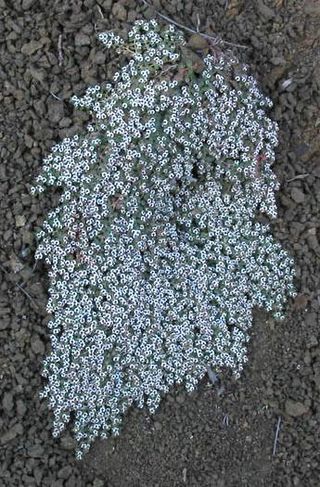
Euphorbia polycarpa is a species of spurge known by the common name smallseed sandmat. It is native to the southwestern United States and northern Mexico, especially the deserts and other dry, sandy areas. This is a perennial herb producing stems that trail along the ground to form a clump or mat, sometimes growing somewhat upright. The leaves are each under a centimeter long. They are round or oval-shaped and have triangular stipules at the bases. What looks like a single flower is actually an inflorescence of many staminate (male) flowers united around a single central pistillate (female) flower. Bracts surrounding the flower unit are white and petal-like. The fruit is a thin spherical capsule less than 2 millimeters wide layered over a seed.
Euphorbia chamaesyce, is an annual plant in the family Euphorbiaceae. It is native to North Africa, Europe and Asia.

Euphorbia fendleri is a species of Euphorbia known by the common name Fendler's sandmat. It is native to much of the southwestern and central United States and northern Mexico, where it grows in scrub and woodland habitat in desert and plateau regions. This is a mat- or clump-forming reddish-green plant with a crooked, creeping, hairless stem. The leaves are rounded, oval, or spade-shaped, smooth along the edges and generally coming to a point, and not much more than one centimeter in maximum length. The tiny inflorescence is a cyathium with white-edged, scalloped appendages surrounding the actual flowers. There is a ring of 25 to 35 staminate flowers around one pistillate flower. The ovary of the pistillate flower enlarges into a lobed fruit about 2 millimeters long.
Euphorbia hooveri is a species of euphorb known by the common names Hoover's sandmat and Hoover's spurge. It is endemic to California, where it grows in the rare vernal pools of the Central Valley. Due to the elimination of most of its habitat, it became a federally listed threatened species in 1997.
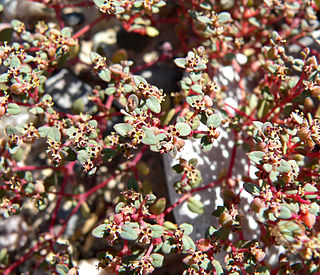
Euphorbia micromera is a species of flowering plant in the family Euphorbiaceae. It is known by the common name Sonoran sandmat. It is native to the southwestern United States from California to Texas, and northern Mexico, where it grows in sandy soils in desert and other dry habitat. It is an annual herb forming a small mat of slender stems. The hairy to hairless leaves are oblong in shape and just a few millimeters long. The tiny inflorescence is a cyathium less than a millimeter wide. It lacks the appendages that many similar species have in their cyathia. It has only a central female flower and 2 to 5 male flowers surrounded by round red nectar glands. The fruit is a minute round capsule.

Euphorbia nutans is a species of Euphorbia known by the common names eyebane and nodding spurge. It is native to much of the United States, Eastern Canada, Mexico, Central America, the Caribbean, and Venezuela.
Euphorbia ocellata is a species of Euphorbia known by the common name Contura Creek sandmat. It is native to the southwestern United States where it grows in many types of habitats. This is a small annual herb with pairs of oblong to lance-shaped leaves, each leaf up to about 1.5 centimeters long. The inflorescence is a cyathium only 2 millimeters wide. It consists of petal-like appendages surrounding the actual flowers, each with a round nectar gland at its base. The appendages are sometimes absent. The flowers include one female flower ringed by up to 60 male flowers. The fruit is a lobed, spherical capsule less than 3 millimeters wide.

Euphorbia prostrata is a species of spurge known by the common name prostrate spurge or prostrate sandmat.
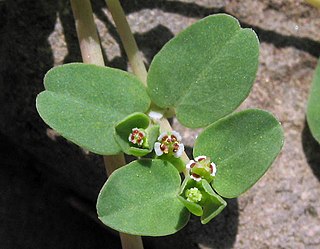
Euphorbia serpens is a species of Euphorbia known by the common name matted sandmat. It is native to South America but it can be found on most continents as an introduced species and often a weed. This is an annual herb forming a mat of prostrate stems which root at nodes where the stem comes in contact with the ground. The oval leaves occur in oppositely arranged pairs, each leaf less than a centimeter long. The inflorescence is a cyathium with scalloped white petal-like appendages surrounding the actual flowers. A red nectar gland is at the base of each appendage, and at the center of the cyathium are several male flowers around one female flower. The fruit is a lobed, spherical capsule.
Euphorbia deppeana is a rare species of flowering plant in the family Euphorbiaceae known by the common names Deppe's broomspurge and Oahu sandmat. It is endemic to Oʻahu, Hawaii, where it is known from only one population in moist shrublands on Nuʻuanu Pali. Like other native Hawaiian euphorbs it is called ʻakoko locally.
Euphorbia eleanoriae is a rare species of flowering plant in the euphorb family known by the common name Nā Pali sandmat. It is endemic to Kauaʻi, Hawaii. Like other native Hawaiian euphorbs it is called ʻakoko locally. This plant was only discovered in 1992 and described to science in 1996 as Chamaesyce eleanoriae. At that time there were fewer than 500 plants known, all occurring in small populations scattered across the sheer cliffs along the Nā Pali Coast of Kauaʻi. By 2001 the total population had already dropped; only three populations were found, for a total of fewer than 50 plants. The plant was federally listed as an endangered species of the United States in 2010.
Euphorbia herbstii is a rare species of flowering plant in the family Euphorbiaceae known by the common name Herbst's sandmat. It is endemic to Oʻahu, Hawaii, where it is rapidly disappearing. Like other Hawaiian euphorbs, this plant is known locally as ʻakoko. It is a federally listed endangered species of the United States.
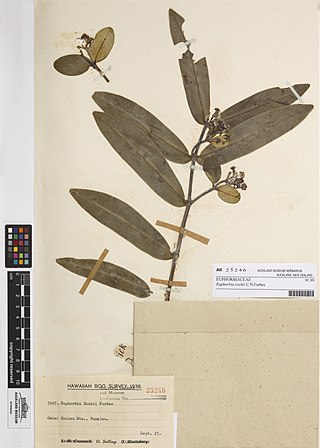
Euphorbia rockii is a rare species of flowering plant in the euphorb family known by the common names Koolau Range sandmat and Rock's broomspurge. It is endemic to Oʻahu, Hawaii, where it is known only from the Koʻolau Mountains. There are 200 to 300 plants remaining. Like other Hawaiian euphorbs, this plant is known locally as ʻakoko.

Euphorbia skottsbergii is a rare species of flowering plant in the euphorb family known by the common names coastal sandmat and Skottsberg's broomspurge. It is endemic to Hawaii, where it is found in coastal shrublands on Oʻahu, Molokaʻi, Maui, and Kahoʻolawe. Like other Hawaiian euphorbs, this plant is known locally as ʻakoko.

Euphorbia psammogeton, commonly known as sand spurge, is a flowering plant in the family Euphorbiaceae. The specific epithet derives from the Greek psammos (“sand”) and geiton (“neighbour”), alluding to the typical habitat.

Euphorbia missurica, commonly called prairie sandmat, or Missouri spurge, is a species of flowering plant in the spurge family (Euphorbiaceae). It is native to North America, where it is found primarily in area of the Great Plains. Its natural habitat is in dry, often calcareous areas, including glades, bluffs, and open woodlands.
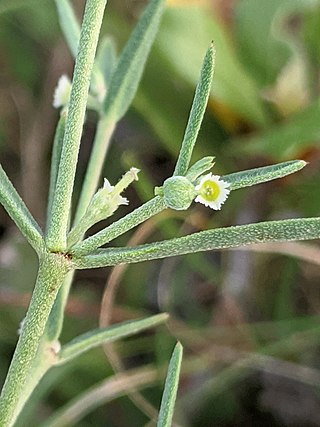
Euphorbia angusta is a species in the Euphorbiaceae (spurge) family with the common name blackfoot sandmat. It is native to central and south Texas and northern Mexico.















